Reviews
Ralph Bakshi
USA, 1982
Credits
Review by Tyler Wilcox
Posted on 25 April 2011
Source Warner Bros. VHS
Categories Ralph Bakshi’s Cool Worlds
Had Ralph Bakshi’s grotesque 1950s fantasia Hey Good Lookin’ been released in 1975 - when it was originally made as a mixture of live action and animated footage - the film might’ve ridden the then-cresting wave of nostalgia for the Eisenhower era. That wave was responsible for American Graffiti, Happy Days, and Grease, those mild representations of idyllic suburban life just prior to the seismic social shifts of the 1960s. Alas, Bakshi’s backers at Warner Bros. found the finished film to be unsatisfactory and shelved it. Several years later, following the success of superficially similar “adult” animated musicals, Heavy Metal and Bakshi’s own American Pop (not to mention Happy Days’ ongoing popularity), Bakshi scrapped the live action elements of Hey Good Lookin’ and in 1982 released a fully animated version—to fairly deafening silence from U.S. filmgoers.
Of course, Hey Good Lookin’ is no Happy Days. Its depiction of sordid sex and violence amidst the gangs of mid-50s Brooklyn is closer to Hubert Selby Jr. than Garry Marshall. If Tex Avery had ever adapted Last Exit To Brooklyn, it might look a little like Bakshi’s strange, mostly unpleasant film. Hey Good Lookin’ doesn’t scratch any particular nostalgic itch. Rather, it sets the viewer smack dab in the middle of a fairly horrific vision of the 1950s - misogyny, racism, brutality, you name it - with all the accompanying ugly sights, smells and sounds fully represented. It’s no mistake that the film kicks off with a conversation between a garbage can and a heap of trash (about the concept of heaven, naturally). It’s a nasty film, and quite purposefully so.
Told in flashback form, Hey Good Lookin’ is centered on two teenage hoods, Vinnie and “Crazy” Shapiro, whose friendship is reminiscent of Harvey Keitel and Robert DeNiro’s characters in Mean Streets. The similarity is not a coincidence: both Romanus and Proval appear in Scorsese’s film. The pair’s relationship is defined by violence: they’re both members of the Stompers gang, and are introduced sparring, playfully, sort of, though there seems to be real anger lurking beneath the surface. Crazy, despite being, you know, crazy, has an artistic temperament, something we learn when he tells Vinnie of his desire to draw pictures of the city. Vinnie isn’t impressed: “Two million faggots in Greenwich Village who wanna be just like ya. Ya wanna be two million and one?”
A life in the arts sufficiently scuttled, Vinnie and Crazy turn their attentions to girls and gangs, like any self-respecting ne’er-do-wells. Their friendship is tested when Vinnie falls for Rozzie, a scantily clad cartoon sexpot who makes Jessica Rabbit look like Mother Superior. Juggling love (or lust, more accurately) with the needs of the increasingly unhinged Crazy proves to be a difficult task for Vinnie. In order to prove to Crazy that he hasn’t lost his edge, he initiates a “rumble” between the Stompers and the Chaplains, a rival black gang. The events leading up to the rumble are disastrous, including murder, betrayal and bad doo-wop pastiches.
About Hey Good Lookin’s soundtrack: it’s terrible. Enticingly, the original (the one that was a mix of animation and live action) allegedly featured legendary NYC glam rockers the New York Dolls, who would actually fit quite nicely in the film’s trashy depiction of the Big Apple. The 70s version was also scored by cult singer-songwriter Dan Hicks. But the Dolls and Hicks are nowhere to be heard or seen in Hey Good Lookin’s available print. Instead, the audience is subjected to the painfully earnest musical stylings of Rick Sandler and John Madara, whose ungainly blend of 50s pop rock and 80s post-new wave makes for uneasy listening indeed. The peppy, polished title song is an ill fit for the grimy setting of the film—a closer cousin of Kenny Rogers’ “Footloose” than, say, Link Wray’s “Rumble.”
It’s possible Bakshi might have recognized the utterly neutered nature of the songs—he often juxtaposes the songs with wildly inappropriate images. For instance, as a mawkish love ballad plays, he shows Vinnie clumsily manhandling and exposing Roz’s breasts, while a group of Stompers look on. Feel the romance! And the goofy music that accompanies the rumble that the entire film has been leading up to is so off the mark that it destroys any tension that the director has built up over the preceding hour. Even the characters seem to realize this—their first impulse is not to fight, but rather to perform some impressively stupid dance moves.
As a counterpoint to some of the idealized depictions of the 1950s found in films and on television, Hey Good Lookin’ can be counted as a success. The decade looks unbearable in Bakshi’s hands. Unfortunately, the film itself is a bit unbearable, too.
More Ralph Bakshi’s Cool Worlds
-
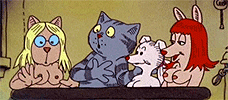
Fritz the Cat
1972 -
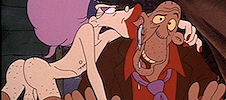
Heavy Traffic
1973 -
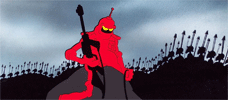
Wizards
1977 -
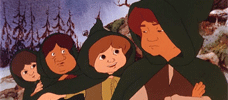
The Lord of the Rings
1978 -
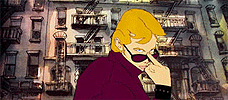
American Pop
1981 -
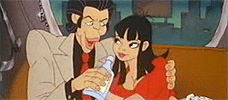
Hey Good Lookin’
1982 -
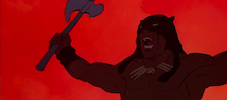
Fire and Ice
1983 -
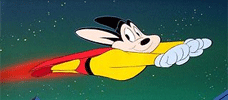
Mighty Mouse: The New Adventures
1987–1988 -

Cool World
1992 -
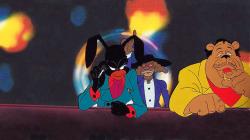
Coonskin
1975
We don’t do comments anymore, but you may contact us here or find us on Twitter or Facebook.



